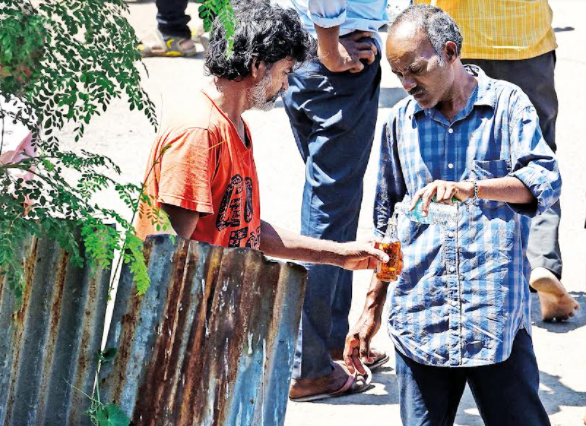How Many Bootleggers To Get Drunk
It was past midnight. There was a sparkle in Das's eyes — as golden as the drink he poured. "Asal sarakku (original stuff)," he told himself while fishing out a water sachet from his overcrowded pocket. His seasoned canine tooth made a precision puncture on the sachet, and a jet of water landed on the Monitor whiskey, bringing up froth in the tumbler and a smile across his face. The 90ml drink (a cutting, as they call it) with half as much water was over in a quick bottoms-up. Das wiped his lips, produced a banana from where the water packet had materialised, ate it in more swallows than bites, and rode past the DGP office next door.
That was 20 years ago when my then employer paid for my 'working expenses' to do a story on 'Life in Tasmac bars' in Chennai. Today, if I have to do it again, the story wouldn't be much different, but it would be told with more facts and less flourish: Illegal bars under the Tasmac banner selling unbilled liquor at inflated rates past the closing time, causing neighbourhood nuisance, drunk driving and accidents. Disclaimer: I support the right to drink and hope our cities will have a better night life. If you find the last two sentences contradictory, the reason is the government.

We have a flawed excise policy. Tasmac – which, for some strange reason, stands for Tamil Nadu State Marketing Corporation – enjoys the monopoly to sell liquor. Exceptions are clubs and hotels (with a certain number of rooms and a liquor permit) that charge at least four times the MRP of alcohol. The result is crowded Tasmac bars, many of them illegal. At night, tipplers spill over to roads, making it difficult, especially for women. If you see a big bunch of motorbikes parked by the road, you can be reasonably sure there is a Tasmac outlet nearby. That should also tell us how many people drive drunk.
Having raked in Rs33,746 crore in 2020-21, Tasmac is the government's biggest cash cow. Giving liquor permits to restaurants and smaller bars may bring down this revenue, but the permit fees will make up for a considerable part of it. The rest can be mopped up if Tasmac runs its authorised bars well, at a low premium. This legalises bars, provides the customer basic quality and choices that fit his pocket. So why is the government not doing it? The answer, in one word: Corruption.
Tasmac outlets drive a parallel, illegal business fuelled by overpricing and bootlegging (what else do you call selling liquor past the closing time at a higher price?) Despite petitions and court directives to adhere to MRP, Tasmac cares a damn. A beer with an MRP of Rs150 is sold at Rs160 (cooling charge, sir, the helpful counter staff tells you while handing over the warm beer); a 750ml bottle of whiskey is sold at Rs40 extra.
TOI journalist Yogesh Kabirdoss, who has been studying corruption in Tasmac, quantifies the crime: The 5,425 Tasmac outlets across Tamil Nadu sell about 52 lakh cases of liquor and 25 lakh cases of beer a month. One case of liquor has 48 bottles of 180ml each. At an average of Rs7.5 above the MRP per 180ml, the black money from liquor adds up to Rs180 crore a month. Assuming the booty from beer is just one-sixth of IMFL, it's a clean killing of Rs210 crore a month.
The spoils, as a friendly employee at an outlet tells me, "go all the way up". And the change of government has not changed the liquor vendor's dubious ways. When the neighbourhood Tasmac outlet sells a bottle at MRP and gives a bill, I will say my first "cheers" to the Stalin government.
How Many Bootleggers To Get Drunk
Source: https://timesofindia.indiatimes.com/blogs/chennaitalkies/when-govt-liquor-vendor-is-a-bootlegger-drunk-on-corruption/
Posted by: ervinligem1969.blogspot.com

0 Response to "How Many Bootleggers To Get Drunk"
Post a Comment